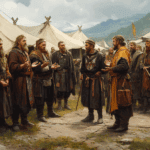
The Brehon laws of ancient Ireland stand as a testament to the rich cultural and legal heritage of the Emerald Isle. This sophisticated system of jurisprudence governed Irish society for over a thousand years, from the Celtic era until the 17th century when it was finally supplanted by English common law. Far from being a primitive set of rules, the Brehon laws were a complex and nuanced legal code that addressed various aspects of Irish life, from property rights to social status, and even beekeeping.
Origins and Development

The term “Brehon” comes from the Irish word “breitheamh,” meaning judge. These laws were initially part of an oral tradition, passed down through generations of legal experts known as Brehons. It wasn’t until the 7th century that these laws were first committed to writing, a process that continued for several centuries thereafter.
The Brehon laws have their roots in Celtic traditions, with linguistic evidence suggesting that many of the fundamental principles date back to at least 1000 BCE. This ancient origin is reflected in the laws’ content, which often describes a society of mud huts and small ringed settlements, where wealth was measured in cattle and bacon.
The Brehons: Custodians of the Law

Central to the Brehon legal system were the Brehons themselves. These were not judges in the modern sense, but rather legal experts who were deeply versed in the intricacies of the law. Brehons underwent extensive training, often spanning up to twenty years, to master the complex legal traditions.
The role of the Brehon was hereditary, passed down within certain families. This created a class of professional jurists who dedicated their lives to interpreting and applying the law. The MacEgan family, for instance, was renowned for producing skilled Brehons, with historical records showing that powerful figures like Piers Rua Butler employed multiple Brehons from this family.
Key Principles and Unique Features
The Brehon laws were primarily civil rather than criminal in nature. They focused on compensation for harm done and the regulation of property and contracts, rather than punishment for crimes. This approach reflects a society that prioritized restoration and balance over punitive measures.

Status and Honor
One of the most distinctive features of Brehon law was its emphasis on social status. Irish society under this system was highly hierarchical, with an individual’s rights and responsibilities closely tied to their rank. This status was not solely determined by birth but could be influenced by factors such as wealth, profession, and personal honor.
Women’s Rights
Surprisingly for its time, Brehon law afforded women a degree of rights and independence that was uncommon in contemporary European societies. Women could own property separately from their husbands and had the right to divorce under certain circumstances. The Cáin Adomnáin, a Christian-influenced law promulgated in 697 CE, even sought to elevate the status of women, though its practical effects are debated.
Marriage and Divorce
The Brehon laws recognized various forms of marriage and provided for divorce on multiple grounds. Property division in case of separation was based on each spouse’s contribution to the household. Interestingly, while a husband was legally permitted to “correct” his wife physically, if the blow left a mark, she was entitled to compensation equivalent to her bride-price and could choose to divorce him.
Property and Inheritance
The laws governing property and inheritance were intricate and varied. The system of land tenure known as gavelkind ensured that property was divided among all sons, both legitimate and illegitimate. This practice contrasted sharply with the primogeniture system common in much of Europe.
Fascinating Specifics of Brehon Law
The Brehon laws covered an astonishing array of subjects, often in minute detail. Some of the more intriguing statutes include:
On Social Status
- Harpists were the only musicians considered of noble standing. Other performers, including flute players and jugglers, had no independent status and were valued only in relation to their patron.
- Poets who overcharged for their work could be stripped of half their rank in society.
On Property and Contracts
- Creditors holding personal items as collateral were required to return them for important social gatherings, or face fines for the debtor’s humiliation.
- The price of land was standardized: 24 cows for the best arable land, 12 for dry, coarse land.
On Relationships and Family
- February 1st was designated as the day when spouses could decide to end their marriage.
- A man who neglected to visit his wife in her bed could be fined.
- If a pregnant woman craved food and her husband withheld it out of stinginess, he was liable to pay a fine.
On Health and Medical Practice
- Strict rules governed the environment for healing: no fools, drunks, or female scolds were allowed in a doctor’s house where a patient was recovering.
- If a doctor’s negligence or lack of skill caused a healed wound to reopen, they were required to return their fee and pay damages as if they had inflicted the wound themselves.
On Hospitality and Social Responsibility
- There was a legal obligation to feed and care for any guest who came to one’s door, without asking questions.
- The elderly were entitled to specific care from their families, including a daily oatcake, regular bathing, and a set amount of firewood.
The Decline of Brehon Law
The Norman invasion of Ireland in 1169 marked the beginning of the end for Brehon law. The invaders brought with them English common law, which gradually began to supplant the native legal system. However, the process was slow and incomplete. Many Norman settlers, particularly those outside the English-controlled Pale around Dublin, adopted Irish customs and continued to use Brehon law.
The Tudor conquest of Ireland in the 16th century dealt a more severe blow to the Brehon system. In 1600, the cornerstones of Brehon law – Tanistry and Gavelkind – were specifically outlawed. The Flight of the Earls in 1607 further weakened the old Gaelic order that had supported the Brehon system.
Despite these setbacks, elements of Brehon law persisted in some areas, particularly in the Gaeltacht regions of western Ireland and the Scottish Isles. On the Isle of Lewis, for instance, the Morrison clan continued to hold the hereditary position of brieve (judge) for the MacLeod clan into the 17th century.
Legacy and Modern Relevance

While Brehon law is no longer practiced in Ireland, its influence can still be felt. Some modernized concepts have been readopted in the laws of the Republic of Ireland, and in rare cases, vestigial rights based on Brehon law have been recognized in recent Irish case law.
The study of Brehon law provides valuable insights into early Irish society and its values. It reveals a culture that prioritized social harmony, respected women’s rights to a degree unusual for its time, and had sophisticated systems for dealing with property and social relations. Moreover, some aspects of Brehon law, such as its focus on restorative justice rather than punishment, resonate with modern legal thinking. As societies grapple with issues of criminal justice reform, the principles underlying Brehon law may offer food for thought.




